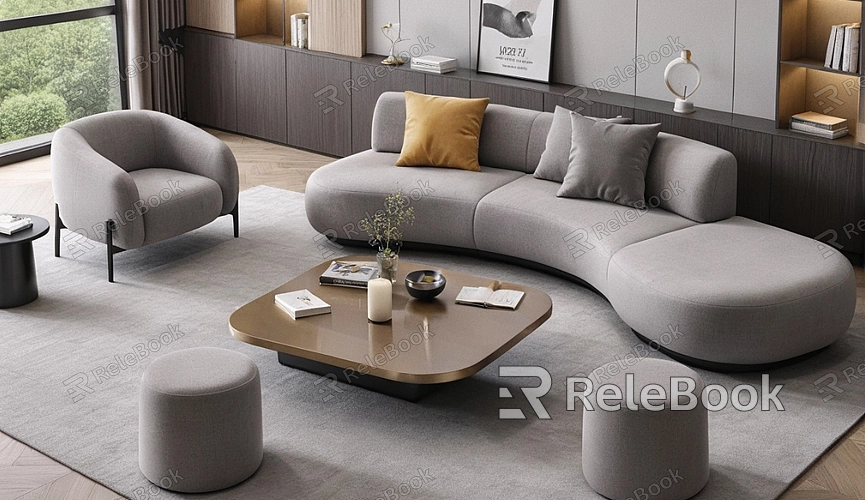How to Find the Centerline of a 3D Model in SketchUp?
When working with 3D modeling, especially using tools like SketchUp, it’s often necessary to accurately locate the centerline of a model. This not only helps in making symmetric adjustments and optimizing the design, but it’s also crucial when preparing the model for rendering or printing to ensure the geometric structure aligns as expected. This article will provide a detailed guide on how to find the centerline of a 3D model in SketchUp, offering practical tips and methods to help you work more efficiently.

What Is a Centerline?
A centerline refers to the axis of symmetry in the geometry of a model or object. It is commonly used to represent the balance of an object, ensuring that it is symmetrical along specific axes. In many types of design, such as mechanical and architectural work, finding and using the centerline of a model is essential.
In SketchUp, the centerline serves not only as a visual guide but also as a crucial reference when making precise measurements or adjustments to your model. Having an accurate centerline can help ensure symmetry along different axes or assist in making corrections. Understanding how to find and use a centerline is an essential skill for every SketchUp user.
Creating an Auxiliary Centerline with the Line Tool
One of the simplest ways to find the centerline of a model in SketchUp is by manually creating auxiliary lines to mark the center. Follow these steps to quickly locate the centerline:
1. Activate the Line Tool
First, select the "Line" tool in the toolbar. This is one of SketchUp's basic drawing tools, which you can activate by clicking the corresponding button in the left toolbar or using the shortcut key.
2. Identify the Geometric Center of the Model
When locating the centerline, you can use the "Push/Pull" tool to inspect the size and shape of the object. Based on the size of the model, choose a reference face that can represent its center. For instance, if you’re working with a rectangular box, select one of its faces as a reference and find the center of that face.
3. Draw the Reference Line
Once you've selected the reference face, use the Line tool to draw a vertical or horizontal centerline on that face. This line will represent the geometric center of the model. To ensure precision, keep the line either vertical or horizontal, and you can use SketchUp’s inferencing features or input specific angles and coordinate values to position the line accurately.

Using the Measurement Tool to Precisely Locate the Center
For more precise centerline placement, SketchUp’s "Tape Measure" tool can help you get accurate measurements and locate the center of the model. By measuring and marking the center points on each part of the model, you can make adjustments with a higher level of precision.
1. Activate the Measurement Tool
Select the "Tape Measure" tool in the toolbar. This tool is used for measuring distances and angles in SketchUp, and you can quickly activate it with a shortcut key.
2. Select a Reference Face for Measurement
Choose a part of the model to serve as the reference face. When measuring, ensure that the face is flat, as this will allow you to calculate the center coordinates more easily.
3. Precisely Locate the Centerpoint
Using the tape measure tool, calculate the center of the reference face. You can input specific values to ensure that the center point is correct along all axes. Once you’ve found the center, use the Line tool to draw an auxiliary line marking this point.
Using Components and Groups to Find the Center of a Model
In SketchUp, components and groups are useful for organizing your model. When working with multiple objects, it’s more efficient to find the center of an entire component or group.
1. Select the Component or Group
First, select the component or group you need to locate the center of. You can do this by clicking on any part of the model and then using the "Select" tool.
2. View the Component’s Center
After selecting the component or group, right-click on it and choose "Entity Info" from the context menu. In the panel that pops up, you will see the geometric center of that component or group. This information makes it easy to quickly determine the centerline.
3. Add a Centerline Marker
Once you have located the geometric center, you can use the Line tool to mark this point as a reference for future adjustments.
Using Symmetry and Mirroring Tools to Automatically Generate a Centerline
SketchUp also offers plugins that can help automatically generate centerlines and symmetrical elements. These tools are especially useful for more complex models, where manual operation might not be as efficient or precise.
1. Install a Symmetry Plugin
To begin, install a relevant symmetry plugin from the SketchUp Extension Warehouse. There are many plugins designed for symmetry and mirroring, and they can help automate the process of finding and creating centerlines.
2. Use the Plugin to Generate a Centerline
Once the plugin is installed, follow the instructions provided by the plugin to select your model or component. The plugin will automatically calculate and create the centerline for you. This method is especially useful for more complex models, as it saves time and ensures accuracy.
Using the Axes Tool for Centerline Marking
Another way to find and mark the centerline in SketchUp is by using the "Axes" tool. This tool allows you to set up custom axes to help define the centerline of your model.
1. Activate the Axes Tool
Select the "Axes" tool in the toolbar. This tool is used to set up custom coordinate axes in your model, providing a reference point for creating centerlines.
2. Set the Position of the Axes
Adjust the axes based on the geometry of your model. These axes will serve as your base for drawing the centerline, helping you to pinpoint the exact center.
3. Use the Axes as a Reference
Once the axes are set, you can use them as a reference for drawing the centerline with the Line tool, making the process quicker and more accurate.
Finding the centerline of a 3D model in SketchUp is an important part of the modeling process. By using the Line tool, the Tape Measure tool, and referencing components and groups, you can easily locate the centerline. For more complex models, using axes or symmetry plugins can significantly simplify the process. Mastering these techniques will help you work with greater precision and efficiency. After learning these tips, you can further enhance your modeling workflow by downloading additional 3D models and textures from Relebook.
FAQ
How can I quickly find the center of a model in SketchUp?
You can quickly find the center of a model using the tape measure tool, the line tool, or by referencing the geometric center of components and groups. For more complex models, using axes or symmetry plugins can also help.
How can I ensure that the centerline I draw is accurate?
To ensure the accuracy of your centerline, you can use the measurement tools, input coordinate values, and reference the SketchUp axes to precisely locate and draw the centerline.
Are the centerline and axes in SketchUp related?
Yes, the centerline in SketchUp often refers to the model’s axes. The red, green, and blue axes represent the standard coordinate system, and you can use these axes as a reference to find and mark the centerline.
How can I simplify the process of finding the centerline using plugins?
You can search for symmetry-related plugins in the SketchUp Extension Warehouse. These plugins can automatically calculate and create a centerline, streamlining the process.

